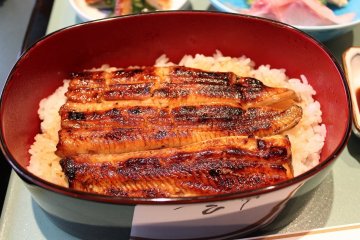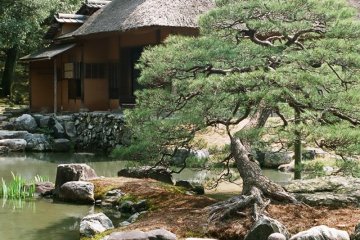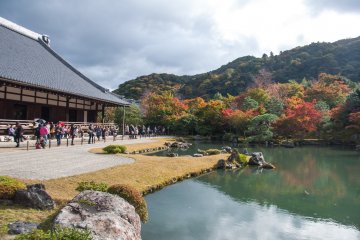

The Saihoji Temple was founded during the Nara period, about 1300 years ago, by the priest Gyōki at the request of the Emperor Shōmu, along with forty-nine other temples of the Hosso sect.
In 1339, in the midst of the devastation of the post-war period, Musō Kokushi, then one of the most respected Zen priests in Japan, revived the temple as a Zen temple at the invitation of Fujiwara Chikahide (the chief priest of the Matsunō shrine).
The complex with an area of 35,000 square meters is now one of the special historical sites and places of scenic beauty in Japan and was included in the list of World Heritage Sites by UNESCO in 1994 as a historical monument of ancient Kyoto. Because of the beautiful moss that covers the area, it is now popularly known as Kokedera (moss temple).
5-minute walk from Kokedera Bus Stop

엑스 카페는 아라시야마 도로변에 위치했는 먹을거리이다. 맛있는 카키고리와 특별한 롤 케이크를 제공하는 이 카페는 트래커들이 교토 더위를 피하기 위해 휴식을 취할 수 있는 아주 좋은 곳이다.

사가노유는 교토의 인기 있는 아라시야마 지역에 있는 약간 독특한 카페다. 이전에 센토 (대중목욕탕)로 쓰였던 이곳은 목욕탕의 흔적을 아직 남긴채 오늘날의 현대식 카페로 리모델링되었다. 타일 아트, 거울과 수도꼭지가 많아 향수를 불러일으킨다. 메뉴는 팬케이크와 디저트, 런치 세트에는 가볍게 샐러드, 파스타나 카레 밥이 있다. 맛있는 러스크 (rusk)와 크래커를 포함한 일본 간식도 판매 중이다. 게다가, 위층에 있는 갤러리에는 장인 실내 장식 모델 (자카)이 전시되어 있다. 사가노유는 오전 11시부터 오후 8시까지 영업하며, 가장 가까운 역은 JR 사가 아라시야마 역과 케이후쿠 전철 란덴 사가 역이다.


The Katsura Imperial Villa, or Katsura Detached Palace, is a villa with associated gardens and outbuildings in the western suburbs of Kyoto, Japan. It is one of Japan's most important large-scale cultural treasures. [Wikipedia] A reservation is required to visit the Katsura Imperial Villa.

The Tenryuji is the main temple of the Rinzai Zen Buddhism sect of the same name and is located in the Arashiyama district in the northwest of the city of Kyoto. It is the most important Zen temple in the city and is a UNESCO World Heritage Site. The temple was built in 1339 by Shogun Ashikaga Takauji, who dedicated it to the recently deceased Emperor Go-Daigo. Both men were former allies until Takauji rebelled against the emperor in the struggle for supremacy in Japan. The temple should pacify the spirit of the deceased. The buildings of Tenryuji have been repeatedly destroyed by fire over the centuries, so that the current complex largely dates from the Meiji period (1868-1912). In contrast, the surrounding garden, which was designed by the well-known master of gardening, Muso Soseki, is still almost entirely original. Especially in autumn, when the foliage of the trees there and the Arashiyama mountains visible behind them turn red and yellow, the Tenryuji and its garden are a popular destination.

The Arashiyama Bamboo Forest is one of the most popular attractions in Kyoto and is made up of numerous trails for visitors to enjoy. For the best photos, make sure to get here early in the morning as it gets crowded very quickly. It's not just the beauty of the bamboo that attracts people. The Arashiyama bamboo forest is one of the 100 most beautiful soundscapes in Japan, which are designated by the Japanese Ministry of the Environment. The sound of the rustling bamboo swaying in the wind is almost meditative. If you walk along the main street of Arashiyama, you will also pass Tenryuji Temple, one of the most beautiful Zen temples in Kyoto. According to Japanese tradition, bamboo is a symbol of strength. Therefore, it often happens that a Buddhist temple or Shinto shrine has a small bamboo grove on its premises to ward off evil.